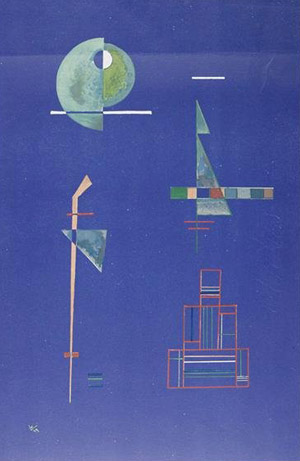
PARIS (AP) – Vassily Kandinsky peers out from a giant photo over the vast hall, welcoming visitors with an impassive gaze to the largest retrospective in two decades years of this nomadic Russian painter’s vibrant, ecstatic and groundbreaking art.
The more than 90 works on display here trace Kandinsky’s course through three wars, three marriages and three countries – Russia, Germany and France, where he died in exile at the end of World War II from his homeland.
The powerful colors and fast-moving forms hanging on stark white walls of Paris’ Centre Pompidou belie the prim bearing of the son of a 19th century well-to-do Moscow merchant whose artistic journey into abstraction helped pioneer a new kind of painting.
The exhibition, which opened this week in Paris, is itself exceptional, drawing from the three largest public Kandinsky collections, owned by the Centre Pompidou, the Guggenheim Museum of New York and the Stadtische Galerie im Lenbachhaus of Munich.
The exhibition, already shown in Munich, travels to New York starting Sept. 18. It features figurative works starting in 1903 to his final painting, in 1942, Delicate Tensions, on loan from a private collection, with pale colors that reflect the ebbing of life. Together, they show that despite the visual fantasy there was nothing fanciful about this former law student’s artwork. Rather it evolved like a mathematical formula fed by inspiration.
Books of poetry, including The Art of Spiritual Harmony, supplement the exhibition, along with Kandinsky’s instructive work as a teacher at the famed Bauhaus school in Weimar, Germany, later moved to Dessau and eventually closed by the Nazis.
“He is evolving all the time. … There is no period without imagination,” said Christian Derouet, French curator of the retrospective.
Figurative early paintings like Song of the Volga (1906) or The Motley Life (1907) evolved into almost geometrically constructed forms and musical movement as Kandinsky dared to defy the artistic standards of the time to open doors to the universe of the abstract.
In Several Circles, (1926) featuring what appear to be bubble-like planetary systems in pinks, yellows and blues on a black void, Kandinsky seems to explore the cosmos, while in other works, like Capricious Forms (1937), he delves into the microscopic world like that held in a drop of water.
For Kandinsky, who actually studied the cells of mice for his art, “there is an infinitely large world and an infinitely small one,” said Derouet. After working with geometric shapes, he looks to “transcend geometry” with other forms, he said.
In 1911, he and German painter Franz Marc created Blaue Reiter, or Blue Rider, an avant-garde movement which linked painting with music, but was forced to an end as World War I erupted. However, horses, already featured in Kandinsky’s earlier works, became significant if mysterious figures, sometimes used to depict flashes of movement.
The key date for Kandinsky is 1921, when, chased out with the October Revolution, he left Russia for Berlin, never to return to his homeland, and began his first explorations with geometric figures.
At that point, said Derouet, the curator, “there is a discovery of the possibility of making paintings that escape conformity … that later we will call abstract.”
In some paintings in his German years, often square, there is neither a top nor a bottom.
Kandinsky settled in France in 1933 in the Paris suburb of Neuilly-Sur-Seine, trying out popular Parisian practices such as incorporating colored sand into works. Transcending geometry with amorphous forms, he was more at home with Surrealists like Miro than abstract artists.
Kandinsky died in France in 1944 at age 78. The Centre Pompidou acquired many of his works through Kandinsky’s widow and third wife Nina. The exhibition at the Centre Pompidou runs through Aug. 10.
Copyright 2009 Associated Press. All rights reserved. This material may not be published, broadcast, rewritten or redistributed.
AP-ES-04-09-09 0623EDT

